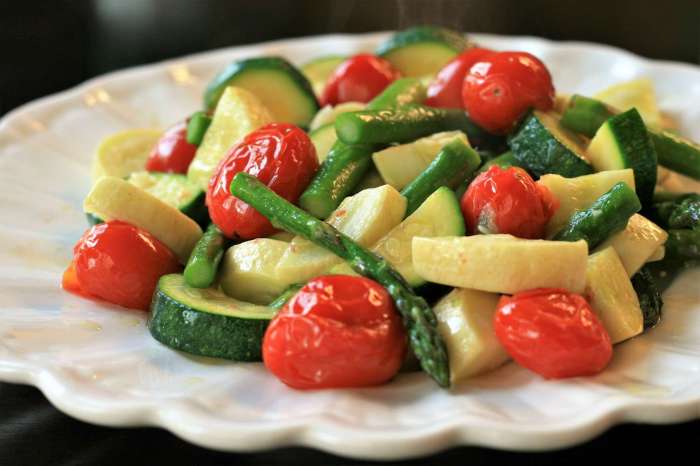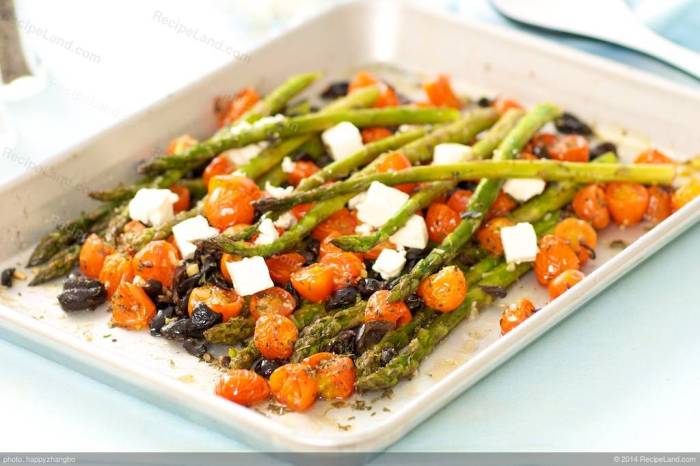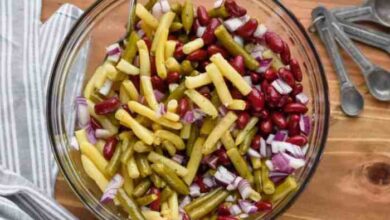
Roasted Asparagus, Zucchini, and Tomatoes: A Flavorful Summer Side Dish
Roasted asparagus zucchini and tomatoes – Roasted Asparagus, Zucchini, and Tomatoes: Imagine a symphony of flavors, where the delicate sweetness of zucchini meets the earthy richness of asparagus, all kissed by the sun-kissed sweetness of tomatoes. This dish is a vibrant celebration of summer produce, offering a burst of color and flavor that will elevate any meal.
This simple yet elegant recipe brings out the best in these seasonal ingredients. Roasting intensifies their natural flavors, creating a dish that’s both healthy and satisfying. Whether you’re looking for a light and refreshing side dish or a flavorful vegetarian main course, this recipe is sure to please.
Roasting Process

Roasting asparagus, zucchini, and tomatoes is a simple and versatile cooking method that brings out their natural sweetness and flavors. The high heat of the oven creates a caramelized exterior and tender interior, resulting in a delicious and satisfying dish.
Roasting Time and Temperature
The roasting time and temperature for each vegetable vary depending on their size and desired doneness.
- Asparagus: Roast at 400°F (200°C) for 10-15 minutes, depending on thickness. Thicker stalks may require a longer roasting time.
- Zucchini: Roast at 400°F (200°C) for 15-20 minutes, depending on size. Cut zucchini into similar-sized pieces for even cooking.
- Tomatoes: Roast at 400°F (200°C) for 20-25 minutes, depending on size. Smaller tomatoes will roast faster than larger ones.
Achieving Crispy Texture
To achieve a crispy texture for asparagus and zucchini, it’s important to roast them at a high temperature and ensure they have adequate space in the oven.
- Space: Avoid overcrowding the baking sheet to allow for proper airflow and even browning.
- High Heat: Roasting at a high temperature, such as 400°F (200°C), encourages browning and crisping.
- Flipping: Flip the asparagus and zucchini halfway through the roasting time to ensure even browning on all sides.
Flavor Enhancement

The beauty of roasting asparagus, zucchini, and tomatoes lies in the flexibility to create a symphony of flavors. With the right blend of herbs and spices, you can elevate this simple dish to new heights.
Flavor Combinations and Herbs
Adding herbs and spices during roasting infuses the vegetables with depth and complexity. Here are some flavor combinations to explore:
- Mediterranean:Rosemary, thyme, oregano, garlic, and a pinch of red pepper flakes create a vibrant and aromatic profile.
- Italian:Basil, garlic, and a touch of red pepper flakes bring out the sweet and savory notes of the vegetables.
- Asian-inspired:Ginger, garlic, soy sauce, and sesame oil add a savory and slightly sweet element to the dish.
- Herby:A mixture of fresh herbs like parsley, dill, chives, and tarragon adds a bright and refreshing touch.
Impact of Spices and Seasonings
Spices and seasonings play a crucial role in shaping the flavor profile of the roasted vegetables.
- Garlic:Adds a pungent and savory aroma that complements the vegetables.
- Onion Powder:Provides a sweet and savory depth of flavor.
- Paprika:Adds a subtle sweetness and a touch of heat.
- Cayenne Pepper:Offers a gentle warmth and spice.
- Salt and Pepper:Enhance the natural flavors of the vegetables and provide balance.
Creating a Flavorful Marinade or Sauce
A flavorful marinade or sauce can elevate the roasted vegetables to a whole new level.Here are some ideas:
- Lemon-Herb Marinade:Combine olive oil, lemon juice, garlic, herbs (like rosemary, thyme, or oregano), salt, and pepper. Marinate the vegetables for at least 30 minutes before roasting.
- Balsamic Glaze:Reduce balsamic vinegar with honey or maple syrup until it thickens into a glaze. Drizzle over the roasted vegetables for a sweet and tangy finish.
- Garlic-Parmesan Sauce:Sauté garlic in olive oil, then add parmesan cheese, cream, and herbs (like basil or parsley). Pour the sauce over the roasted vegetables for a creamy and savory experience.
Alternative Cooking Methods
While roasting is a classic method for asparagus, zucchini, and tomatoes, other cooking techniques can also yield delicious results.
- Grilling:Grilling imparts a smoky char and enhances the natural sweetness of the vegetables.
- Pan-Frying:Pan-frying provides a crispy exterior and tender interior.
Serving Suggestions: Roasted Asparagus Zucchini And Tomatoes
This versatile dish can be enjoyed in various ways, depending on your preferences and the occasion. Whether you’re looking for a simple side dish, a hearty main course, or a refreshing salad, roasted asparagus, zucchini, and tomatoes offer endless possibilities.
Serving as a Side Dish
Roasted asparagus, zucchini, and tomatoes make a delicious and healthy side dish for a variety of meals. Their vibrant colors and distinct flavors complement many main courses.
- Grilled meats and poultry:The roasted vegetables pair beautifully with grilled chicken, steak, or pork chops. The smoky flavors of the grill enhance the sweetness of the vegetables, creating a harmonious blend of tastes.
- Fish:Roasted asparagus, zucchini, and tomatoes can also be served alongside grilled or baked fish. The delicate flavors of the vegetables complement the richness of fish, creating a light and flavorful meal.
- Pasta dishes:Toss the roasted vegetables with your favorite pasta dish for a nutritious and flavorful meal. They add a burst of color and texture, enhancing the overall taste of the pasta.
Serving as a Main Course
For a vegetarian-friendly main course, roasted asparagus, zucchini, and tomatoes can be served with quinoa, couscous, or brown rice.
- Quinoa:The roasted vegetables complement the nutty flavor of quinoa, creating a complete and satisfying meal. To add protein, you can top the dish with grilled tofu or tempeh.
- Couscous:The light and fluffy texture of couscous provides a contrasting texture to the roasted vegetables. You can enhance the flavor by adding herbs and spices like mint, cilantro, or cumin.
- Brown rice:The earthy flavor of brown rice pairs well with the roasted vegetables. You can add a sprinkle of toasted nuts or seeds for extra crunch and flavor.
Serving as a Salad
For a refreshing and flavorful salad, you can combine the roasted vegetables with other ingredients like feta cheese, olives, and fresh herbs.
- Feta cheese:The salty and tangy flavor of feta cheese complements the sweetness of the roasted vegetables. Crumble the feta cheese over the salad for a burst of flavor.
- Olives:The briny flavor of olives adds another dimension to the salad. Choose your favorite olives, such as Kalamata, green olives, or black olives.
- Fresh herbs:A sprinkle of fresh herbs like basil, oregano, or parsley adds a fragrant touch to the salad.
Serving Temperature
Roasted asparagus, zucchini, and tomatoes can be served hot or at room temperature. Serving them hot allows the flavors to intensify, while serving them at room temperature provides a more refreshing option.
Plating Techniques
For a visually appealing presentation, consider these plating techniques:
- Fan the asparagus:Arrange the asparagus spears in a fan shape on the plate. This creates a visually appealing and elegant presentation.
- Layer the vegetables:Create layers of the roasted vegetables on the plate, alternating between asparagus, zucchini, and tomatoes. This creates a visually appealing and balanced presentation.
- Use a drizzle of balsamic glaze:A drizzle of balsamic glaze adds a touch of sweetness and acidity to the vegetables, enhancing their flavor and creating a visually appealing finish.
Variations and Substitutions
This recipe is a great starting point for experimenting with different flavors and textures. You can easily customize it to your liking by using different vegetables, herbs, and cooking methods.
Vegetable Variations, Roasted asparagus zucchini and tomatoes
You can use a variety of vegetables in this recipe. Here are some ideas:
- Other Squash Varieties:Try substituting butternut squash, acorn squash, or spaghetti squash for zucchini. These varieties will add a different flavor and texture to the dish.
- Root Vegetables:Add diced carrots, parsnips, or sweet potatoes for a sweeter and earthier flavor profile.
- Green Beans:Toss in some green beans for a vibrant green color and a slightly crunchy texture.
- Bell Peppers:Add diced bell peppers for a burst of color and a mild sweetness.
- Mushrooms:Include sliced mushrooms for an earthy and savory flavor.
Herb Variations
Experiment with different herbs to enhance the flavor of your roasted vegetables. Here are some suggestions:
- Fresh Thyme:Thyme complements the earthy flavors of the asparagus and zucchini.
- Rosemary:Rosemary adds a strong, piney flavor that pairs well with roasted vegetables.
- Oregano:Oregano provides a slightly bitter and pungent flavor that complements the tomatoes.
- Basil:Basil adds a fresh and slightly sweet flavor that pairs well with the tomatoes and zucchini.
- Parsley:Parsley adds a bright and fresh flavor that complements the asparagus.
Alternative Cooking Methods
While roasting is the most common method for preparing these vegetables, you can also try grilling or pan-frying them.
- Grilling:Grilling the vegetables will give them a smoky flavor and char marks. Simply thread them onto skewers and grill them over medium heat until tender.
- Pan-frying:Pan-frying the vegetables will create a crispy exterior and a tender interior. Heat some olive oil in a large skillet over medium heat and cook the vegetables until browned and tender.
Vegetarian, Vegan, and Gluten-Free Adaptations
This recipe is already vegetarian and gluten-free. To make it vegan, simply omit the cheese.
Storing and Reheating Leftovers
Store leftovers in an airtight container in the refrigerator for up to 3 days. To reheat, simply microwave the vegetables until heated through. You can also reheat them in a skillet over medium heat with a little bit of olive oil.






